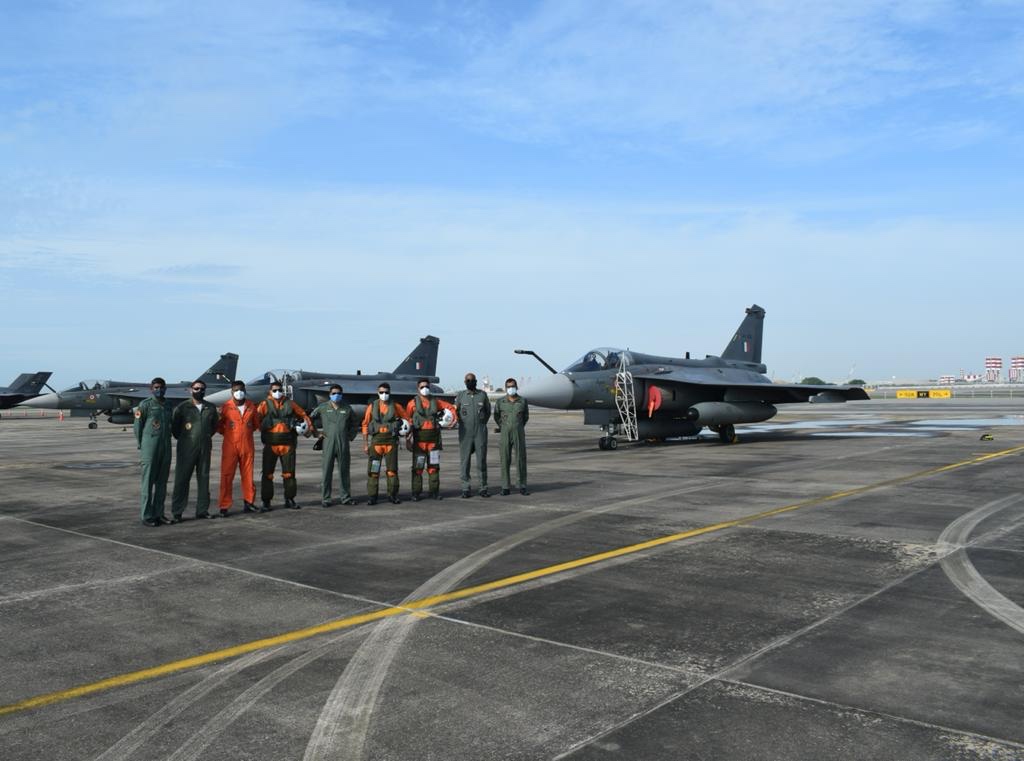
By Vikas Gupta
Defence News of India, 12 Feb 22
A detachment of Tejas Mark 1 fighters flew from the Indian Air Force (IAF) base in Coimbatore to Singapore’s Changi International Airport on Saturday to participate in the Singapore Airshow – 2022 from February 15-18.
The planes are accompanied by an IAF team of 44, who will be responsible for flying, displaying and servicing the Tejas fighters during their daily aerobatic displays in the show.

The IAF will do its utmost to secure an order from the Royal Malaysian Air Force (RMAF), which is seeking to purchase a mix of 36 light fighter variants under its “Capability 55” plan.
Launched in 2018, the plan calls for the acquisition of a mix of light combat aircraft (LCA) and fighter training trainers (FLIT) in two phases – 18 aircraft to be delivered from 2022-23 and 18 more from 2025.
According to authoritative aerospace publishing house Jane’s, the RMAF will split the 36 aircraft between a LIFT and two LCA squadrons.
In June 2021, the Malaysian Ministry of Defense launched the acquisition of the initial 18 aircraft, eight of which will be LIFTs and ten LCAs. Hindustan Aeronautics Ltd (HAL), which manufactures the Tejas, submitted its bid before the September 22, 2021 deadline.
The IAF had previously showcased the performance of the Tejas by displaying the aircraft at world defense and aerospace exhibitions, including the Bahrain International Airshow in 2016, the Langkawi International Maritime Aerospace Expo (LIMA) in 2019 and the Dubai Air Show-2021 last November.
“The IAF will showcase the indigenous Tejas Mark-1 aircraft alongside participants from around the world. The Tejas will captivate audiences with its low-altitude aerobatic display, displaying its superior handling characteristics and maneuverability,” a statement said on Saturday. IAF press release.
Aerospace industry watchers say that in the supersonic LCA category, the RMAF chooses between three light fighters on offer: the Tejas Mark 1, the South Korean FA-50 Golden Eagle, the Russian MiG-35 and the JF-17 Thunder. Sino-Pakistani, which already equips the Pakistan Air Force (PAF).
In the subsonic FLIT category, three less powerful jet trainers are in competition: the M-346FA aircraft from the Italian firm Leonardo, the South Korean T-50 trainer and the Russian Yakovlev-130.
“The IAF’s participation in the air show provides India with the opportunity to showcase the Tejas aircraft and interact with its counterparts from the RSAF (Royal Singapore Air Force) and other participating contingents,” said the Department of Defense.
The RMAF’s “Capability 55” modernization program plans to add a single-engine supersonic fighter to the RMAF’s current fleet, which consists primarily of twin-engine fighters. These include eight Boeing F/A-18D Hornets and 18 Russian Sukhoi-30MKM Flankers. Efforts to replace the RMAF’s older MiG-29 Fulcrum interceptors stalled due to lack of funds.
The RMAF has specified rigorous tender requirements, which include air-to-air refueling, combat beyond visual range (BVR), and supersonic flight capabilities. Manufacturing must be located in Malaysia for 30% of the aircraft and delivery must begin within 36 months of signing the contract.
HAL chief R Madhavan told Defence News of India that almost all RMAF requirements have been met and othersas an on-board oxygen generation system (OBOGS) could be easily designed.
HAL offered the RMAF the sophisticated Mark 1A version of the Tejas, which features aerial refueling, active electronically scanned array radar (AESA), electronic warfare (EW) capability and the ability to fire BVR missiles.
On the other hand, competitors do not meet many of the RMAF requirements. The JF-17 Thunder does not have the specified AESA radar. Turkey does not yet have a flying plane, while any Chinese offer will be treated with suspicion, given Kuala Lumpur’s distrust of Beijing after recent incursions by Chinese planes and warships into the disputed waters of the South China Sea.
The price is also important for the RMAF, which sources say expects to pay around $900 million for 18 fighters, or $45-50 million per fighter. The Tejas is supposed to fall in this price bracket.
The Korean fighter is supposed to be slightly more expensive than the Tejas and the Russian MiG-35 significantly. Meanwhile, the Chinese have reportedly reduced the price of the JF-17 by around 30%, a loss they are willing to bear to win the market.






